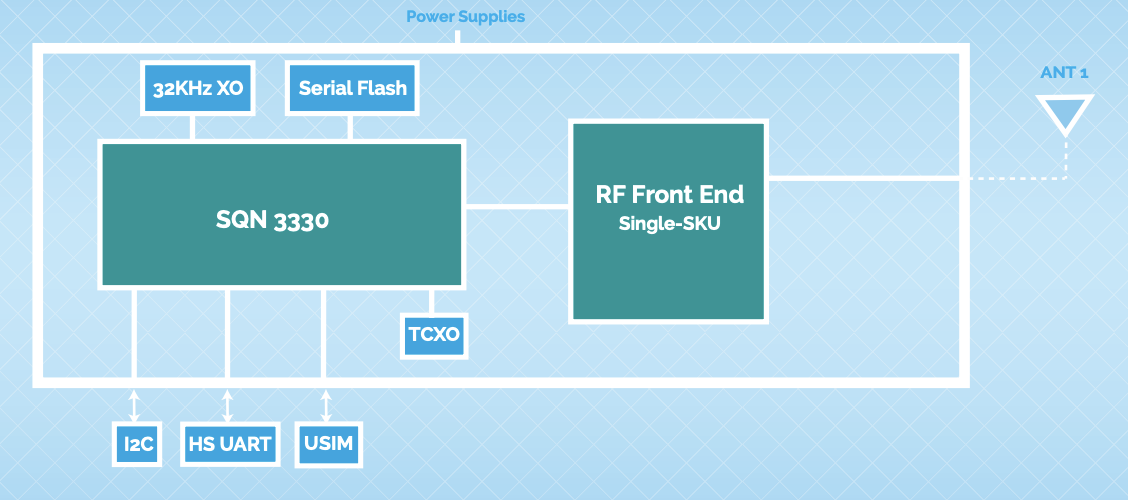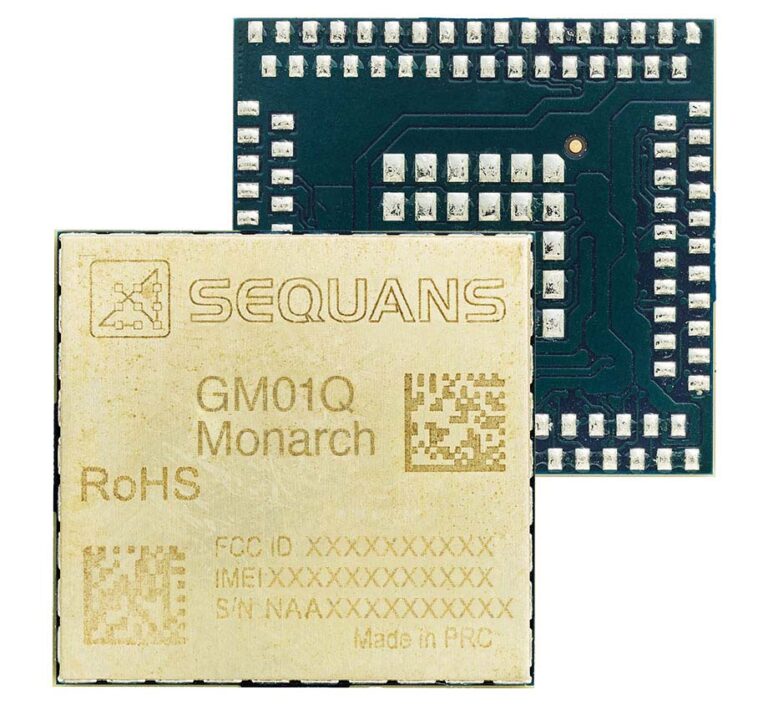Product of the Week: Sequans Monarch Go, Connected by Verizon
March 16, 2021
Blog

Do you know where to start when selecting a modem for your next cellular-enabled IoT device design? You do now.
The Sequans Monarch Go is an all-in-one modem built on Monarch GM01Q module. The FCC-compliant, single-mode LTE IoT Category M1 (LTE-M) modem is flanked by an embedded antenna and pre-installed ThingSpace IoT SIM on the module, and comes pre-certified for use on Verizon LTE band 13 networks. It is even provided with a default data plan.
This makes it truly a drop-in connectivity solution for enhanced machine-type communications (eMTC) on next-generation wireless networks. Literally, all you have to do is plug it in, activate the device from the Verizon ThingSpace online management platform, connect it to cloud services like AWS or Microsoft Azure, and go. There’s no need to re-certify the device if it’s being used in the U.S., and global band support is on the roadmap.
The 16-gram, 35 x 50 x 14.95-mm Sequans Monarch Go LTE Cat M1 modems deliver peak data rates of up to 375 kbps uplink and 300 kbps downlink. The cellular modems support SMS messaging and equip an embedded IP stack with support for protocols such as FTP, HTTP, HTTPS, MQTT, MQTTS, TCP, TFTP, and UDP. They are compatible with host devices running Windows, Linux, and other real-time and embedded operating systems.
The Sequans cellular networking devices also include optional embedded GPS support (Monarch Go-GPS) for location-based services and tracking applications that require accuracies ranging from 1000 meters to less than 5 meters. This feature set makes the Monarch Go, Connected by Verizon, an ideal candidate applications such as telemetry, agriculture sensor monitoring, asset and transportation, tracking, home security monitoring, and so on.
The Sequans Monarch Go, Connected by Verizon, in Action
To support the aforementioned applications, the GPS-enabled version of the Sequans Monarch Go (Monarch Go-GPS) features location update rates of up to 1 Hz, a tracking sensitivity of -162 dBM, and acquisition sensitivity of 148 dBm. However, even the base Monarch Go platform offers positioning based on LTE Cell-ID techniques, which enables location-based services in hard-to-reach areas like underwater gas and water meter installations where GPS is not as effective.
Further supporting these remote, mobile use cases, the Monarch Go platform sports max transmit powers of up to +23 dBm. But just as important, an ultra-low power saving mode (PSM) in which the device consumes as little as 1 µA without GPS and 35 µA with it. Other low-power modes include extended discontinuous reception (eDRX) for deployments in remote areas with intermittent connectivity and radio resource control (RRC) idle.
Developers looking to program the device would do so with a set of AT commands sent over the industry-standard 1.8 V UART interface. While the Monarch Go itself does not contain an application MCU, examples of how the cellular connectivity platform can be connected to a host MCU over UART are provided.
The Monarch Go also includes an industry standard 1.8 V UART interface and a set of AT commands and examples for connection to the device application MCU controller. Also, the Monarch Go requires the user to control the device via an external processor.
Of course, another massive advantage of the platform is integration with the ThingSpace environment, which in addition to data plan selection and management provides firmware over-the air (OTA) update capabilities via the Verizon FOTA service. Connecting the system to a cloud like AWS, Microsoft Azure, or other third-party cloud or geolocation services allows the Sequans Monarch Go, Connected by Verizon, to operate as a linchpin for upgrading deployed devices over time.
Getting Started:
As mentioned, getting started with the Monarch Go platform is exceedingly simple. This even applies to mechanical integration of just the LTE-M modem component, which can be achieved using two screws and a low-profile 20-pin board-to-board connector. No soldering is required.
On the prototyping front, a Monarch Go starter kit, the Monarch Go STK, is available for testing and development. To begin, the user just has to connect the STK into a Windows laptop or host PC using a standard USB 2.0 cable, and follow these simple steps:
- Go to https://thingspace.verizon.com/start and sign up to activate the ThingSpace pre-installed IoT SIM card.
- Your Monarch Go will connect automatically to the Verizon LTE-M network.
- Launch a serial terminal and configure the device as follows:
- 115200 baud rate,
- 8-bit data
- Hardware flow control
- No parity
- 1 stop bit
- Type ATI1 to get the latest software version and AT+PING=”www.sequans.com” to check device connectivity.
- Download the full board documentation from www.sequans.com/monarch-go.
To start your IoT devices down the road to next-generation LTE connectivity, you can purcase the Monarch Go LTE-M modem component through Sequans’ distribution partner, Avnet. Or, learn more in the resources section below.
Resources:
-
Monarch Go Product Page: https://www.sequans.com/monarch-go/
- Monarch Go Product Brief: https://www.sequans.com/wp-content/uploads/2020/01/PI-Monarch-Go-1-20200107-FINAL.pdf
- Monarch GM01Q Module Product Page: https://www.sequans.com/products-solutions/modules/monarch-gm01q-module/
- Monarch Go FAQ: https://www.sequans.com/monarch-go-q-and-a/
- Verizon ThingSpace Overview Page: https://thingspace.verizon.com/solutions/device-solutions/iot-sims.html
- Buy the Sequans’ Monarch Go, Monarch Go GPS, or Monarch Go STK from Avnet: https://www.avnet.com/wps/portal/us/products/new-product-introductions/npi/sequans-monarch-go







